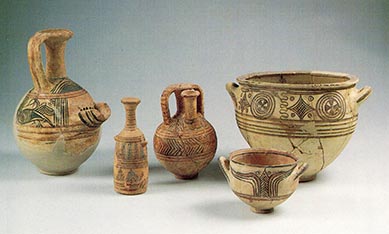The core region of Philistia is centered around the five cities of the so-called Pentapolis: Ashdod, Ashkelon, Gaza, Ekron, and Gath, on the southeastern shore of the Mediterranean Sea, between modern-day Tel Aviv and the Gaza Strip. Because the Philistines are not related to the native Canaanite population of this region, scholars long assumed that they derived from some as-yet-unidentified location in the Aegean, having migrated en masse and largely replaced the indigenous population along the southern coastal plain. Current research suggests a more complex picture.
Early Philistine material culture indicates that the origins of the Philistines are diverse, from various areas in the Aegean, Cyprus, southern Anatolia, and even the Balkans. Evidence shows that the local Canaanite population and culture appear alongside “imported” elements, collectively constituting Philistine culture. The history of Philistia’s cities and the artifacts within indicate a hybrid (I prefer the term “entangled”) culture that from its beginning combined aspects of multiple origins.
Philistine pottery is distinctive and an excellent tool for mirroring the overall development and change of Philistine material culture. Pottery finds from the early Iron Age include locally made Mycenaean pottery, clearly indicating that foreign pottery traditions were brought to Philistia. As the Iron Age progresses, Philistine pottery changes as well, developing its own unique styles (see photo). The latest stage (Ashdod ware), during the Iron Age IIA, is a combination of Philistine and Phoenician forms and decorations. Diet and food preparation also differ between the Philistines and other Canaanite cultures. For example, most, but not all, Philistine sites indicate a preference for pig and dog meat. And cooking vessels (jugs) and installations (hearths) were different in Philistia than in other parts of the region.
The political organization of the Philistines is not clear. Scholars debate whether the five Philistine cities were independent or had some joint political structure. Because there are so few inscriptions from Philistia, much of what we know about the Philistines derives from Assyrian and Babylonian sources and from biblical narratives, where the Philistines are usually described as Israel’s bitter enemies. However, there are a few hints of neighborly relations between the Israelites and Philistines, as in the Samson cycle (
Throughout the Iron Age, a slow but steady process of change can be seen in Philistine culture. Under the influence of neighboring cultures, the Philistines became more and more like their neighbors. Nevertheless, until the very end of the Iron Age, the Philistines seem to have retained a distinct cultural identity. This suggests that Philistine culture, by definition, was an “entangled” culture, one that combined various local and foreign components to create a unique culture that continued to transform throughout the Iron Age.
During the early Iron Age, all five of the Philistine cities were settled, but only Ashdod and Gath were large. Gath, home of the biblical Goliath, was the primary city of the Philistines in the 10th and ninth centuries B.C.E. (Iron Age IIA), the time of the early Judahite monarchy (including David and Solomon). Due to Gath’s dominant position, the Judahite monarchy could not expand westward very far. Following the destruction of Gath by the Aramean king Hazael around 830 B.C.E., the four other cities continued to prosper, but Gath’s destruction enabled the Judahite kingdom to begin to expand in that direction. During the Neo-Assyrian period (mid-eighth to mid-seventh centuries B.C.E.), Philistia prospered. Ashkelon became an important port, and Ekron became the largest producer of olive oil in the eastern Mediterranean. Only with the Babylonian conquest of Philistia around 604 B.C.E., during which all the remaining Philistine cities were destroyed and their inhabitants exiled to Babylonia, do we see the sudden end of Philistine culture.
Bibliography
- Maeir, A. M., ed. Tell es-Safi/Gath I: Report on the 1996–2005 Seasons. Ägypten und Altes Testament 69. Wiesbaden: Harrassowitz, 2012.
- Stager, L. E., J. D. Schloen, and D. M. Master, eds. Ashkelon 1: Introduction and Overview (1985–2006). Harvard Semitic Museum Publications, Final Reports of the Leon Levy Expedition to Ashkelon. Winona Lake, IN: Eisenbrauns, 2008.
- Meehl, M., T. Dothan, and S. Gitin. Tel Miqne-Ekron Excavations, 1995–1996: Field INE East Slope, Iron Age I (Early Philistine Period). Tel Miqne-Ekron Final Field Report Series 8. Jerusalem: W. F. Albright Institute of Archaeology, 2006.




